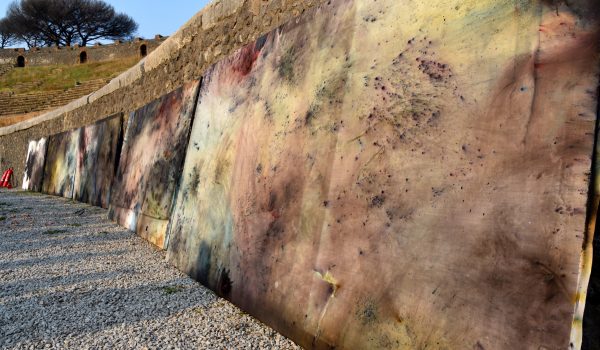The exploded 32-meter long canvas, stretching out among the arches and vaults in the Farnese Sculpture Hall like a ceiling fresco, displays variegated images of the exploded paintings and objects and reflects the entirety of the exhibition. There will be many surprises for those who follow the path traced by CaiGuo-Qiang through the Museum’s collection.In addition to the masterpieces of ancient statuary—copies of the Farnese Herculesand the Venere Callipigia—reinterpreted by Cai through the colors of gunpowder, vases and terracotta objects will be displayed on simple platforms, evoking the everyday life of the Ancient Romans.A boat, anchored to the wall and placed alongside the frescoes of Pompeii, will disclose the timeless secret of an ongoing artistic journey. The evanescent traces of gunpowder on canvas will evoke references to the figures of classical iconography, just as the presence of the extraordinary installations in the various rooms will invite reflection on the continuity between past and present.
"Thanks to the work of Cai Guo-Qiang, the sense of folklore, the atmosphere, and the power of Eastern traditions are broughtto the galleries of the MANN, showinghowthe sharing of culturederives from a similar ability to observe the world with the curiosities of the Ancients”, saysMuseum Director, Paolo Giulierini.
“When Vesuvius erupted, burying the ancient Greek and Roman civilizations, nature created a masterpiece, taking catastrophe as its medium and preserving the monumental heritage as a time-space capsule…”saysCai Guo-Qiang.“The repressed energy of the volcano built up until it could no longer be contained, leading to an unbridled explosion! A similar natural state can also be found in human nature and our social condition, and in the harmony with nature in my decades of work with gunpowder... For this project, I tried to let the hormones take the lead, to create something with a touch of ferocity, at a time when people often strive to be too civilized, carefully polishing, ‘cleaning up’ their works and even the concepts that attempt to explain the meaning of their work. Can I not simply stage an uncontrolled eruption, recalling the volcano and the day of judgment of Pompeii? A completely unexpected event, something that appears right on our path!"
Jérôme Neutres, curator of the exhibition, adds: “Pompeii is more than a museum, it is the city of images, with its houses covered from floor to ceiling with frescoes and mosaics. The city seemed to live with art. For Cai Guo-Qiang, dialogue with Pompeii involves this world of images and its imagination. For this exhibition, Cai Guo-Qiang has used new creative tools, innovatinghis method using glass, mirrors, marble, ceramics, plaster ... In the culture and artistic history of Naples and Campania, the artist has found new media for hisexplosion paintings. This dialogue takes shape in the scenography of the exhibition, setting up Cai Guo-Qiang’sworks within the collections, creating a sort of treasure hunt among the works from Pompeii, moving back and forth between past and present,with mirror effects between the aesthetics of first-century Pompeii and the eminently contemporary art of Cai Guo-Qiang.”
The exhibition will be accompanied by a catalogue (published by Silvana Editoriale in English and Italian; followed by a Chinese edition published by TCREATIVEMEDIA).A documentary video directed by Shanshan Xia (available for public viewing at MANN), will accompany the exhibition.


